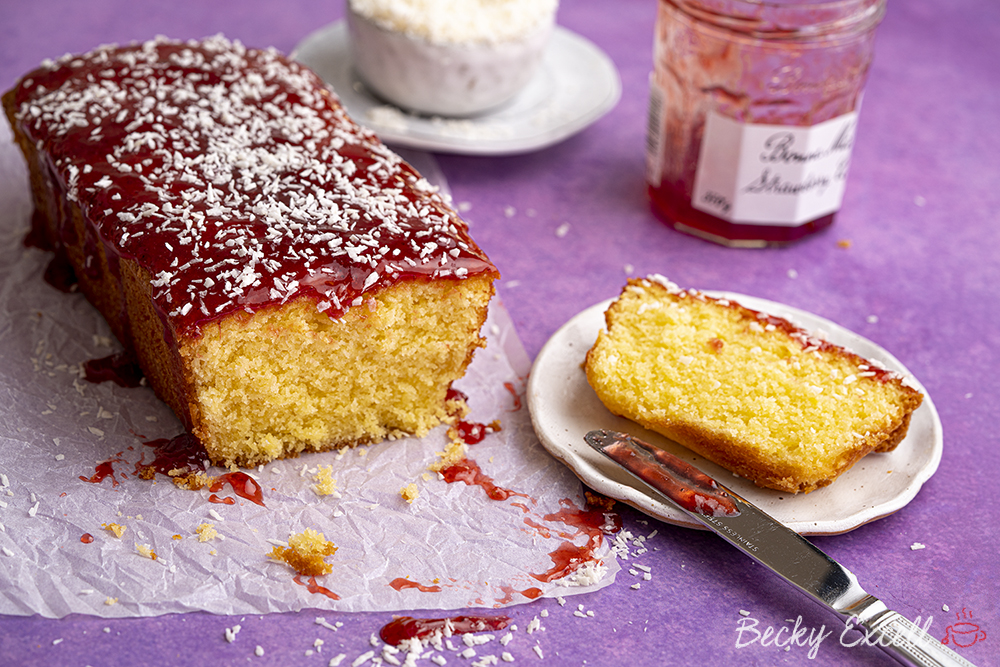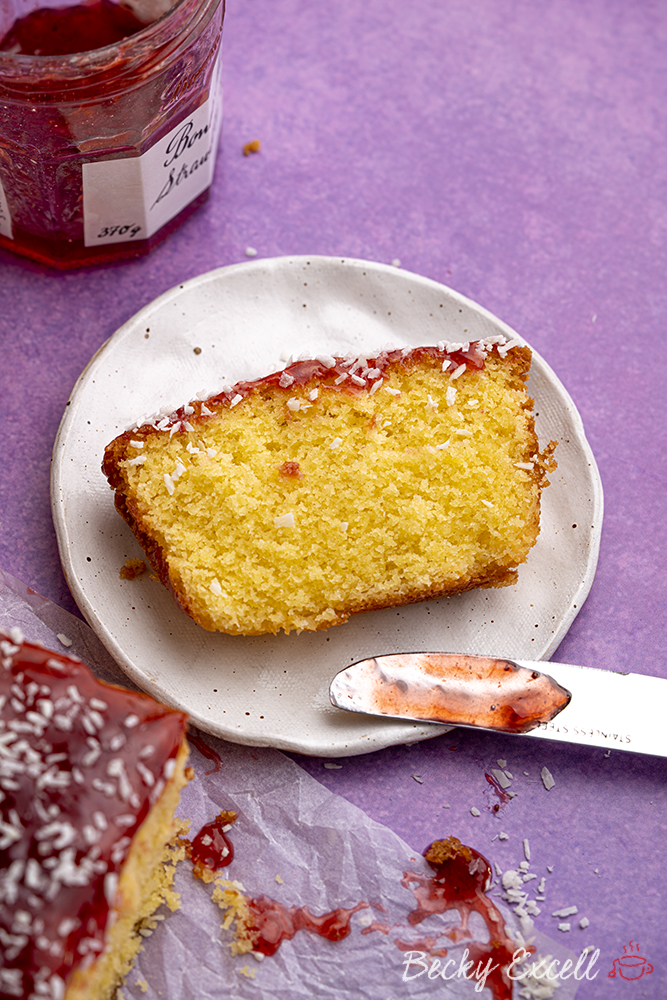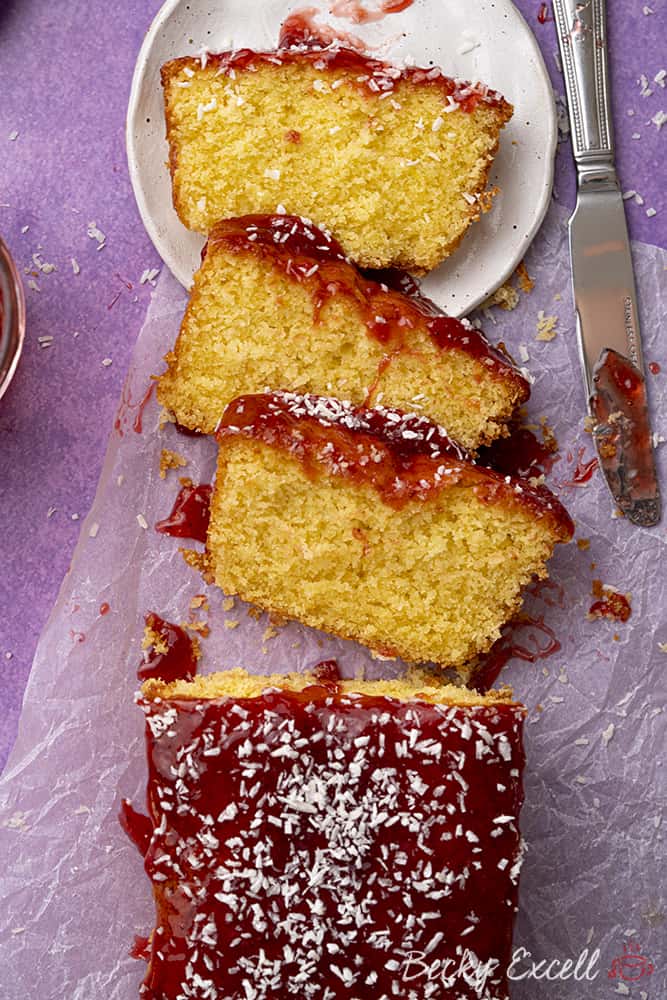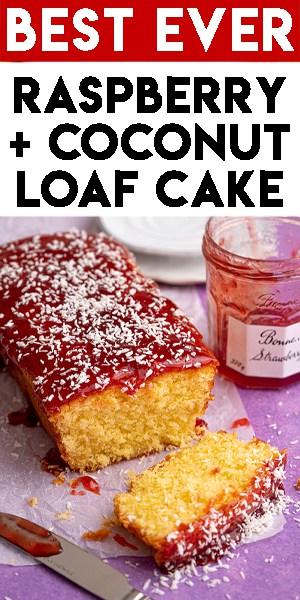Gluten-free raspberry and coconut cake recipe – incredibly easy to make using 8 simple ingredients and no need to make buttercream! Nobody would know it’s Coeliac-friendly and wheat-free.
Gluten-free raspberry and coconut cake recipe, anyone? This absolute classic is 100% beginner friendly – just mix up your sponge, bake it and top with jam. Anyone can make this beauty!
This one is yet another classic bake that’s so incredibly simple to make, yet still worthy of winning you the title of ‘star baker’ with Coeliacs and muggles alike.
I haven’t met a single person who doesn’t love a slice of this cake and considering the amount I come into contact with other humans right now, that doesn’t look like it’ll change anytime soon!
My one top tip here is simple: don’t hesitate to buy good quality raspberry jam if possible.
Of course, it’s gonna taste that little bit better and also have a slightly less ‘jelly-like’ texture, but it’s also usually waaay more red too; definitely something to bear in mind if you’re looking for the ultimate show-stopping finish.
Here’s a few reasons you need to make this if you weren’t convinced already…
Why make my gluten-free raspberry and coconut cake recipe?
- It’s 100% beginner-friendly. The sponge is super easy to make and once baked, all it needs is a little jam and a sprinkle of coconut on top.
- The sponge is golden, soft, light and moist – NOT crumbly or dry at all.
- You only need 8 simple ingredients, all of which you can find in the supermarket.
- You’d never know this recipe was gluten-free AT ALL – yes, even muggles will eat this, so watch out!
- This is super easy to make dairy-free with two simple swaps.
But what does my gluten-free raspberry and coconut cake recipe taste like, I hear you ask?
The sponge is golden and super moist with the unmistakable taste of rich coconut. Needless to say, the combination of coconut and raspberry is a wholly underrated pleasure!
So when you get a taste of that sweet, raspberry jam lathered on top (with a welcome little bit of texture from the sprinkled coconut), let’s just say that you’ll probably be doing some sort of happy dance.
So here’s everything you’ll need for my gluten-free raspberry and coconut cake recipe. Keep scrolling until you see the recipe card below if you’re looking for the method…
Gluten-free raspberry and coconut cake recipe: What you’ll need…
- Butter: Butter is king in cakes and buttercream, but make sure yours is softened before beginning. Leaving it out of the fridge for a couple of hours should do it.
- Caster sugar: Of course, sugar isn’t just for sweetness – it helps to achieve a lovely crisp exterior and helps the cake to form a crumb.
- Eggs: I used large eggs for this recipe, though medium eggs should be fine too.
- Milk: A little splash of milk helps to stop the cake batter from becoming too thick, so don’t skip this!
- Gluten-free self-raising flour: I use a simple commercial blend from the free from aisle in the supermarket. If you can’t find a blend like this where you live, you can always make your own using my gluten-free flour recipe.
- Xanthan gum: This helps to bind the cake crumb together so it doesn’t become crumbly, replacing the gluten that would otherwise do the same job.
- Desiccated coconut: Yep, it’s in the sponge AND on top, adding tons of flavour that works so well with a little sweetness and sticky raspberry jam.
- Raspberry jam: Like I said, the better quality, the better your finished cake will look – it’s usually more red instead of being somewhat black!
So I thought I’d kick things off with a little frequently asked questions section – if you just want the recipe, then keep scrolling.
But I’ve thrown in some tips here that will be really helpful if this is your first time making this, or you want to adapt it. So here they are!
Gluten-free raspberry and coconut cake recipe: Frequently Asked Questions
Can I make this recipe gluten-free? Is it suitable for Coeliacs?
It is gluten-free, though nobody would know just by tasting it – trust me!
Bear in mind that minimising cross-contamination is hugely important if you’re Coeliac or making this for someone who is. Here’s some tips from Coeliac UK on minimising the risk of cross contamination:
Also, make sure that all ingredients used don’t have any gluten-containing ingredients. Then make sure that they also don’t have a ‘may contain’ warning for gluten, wheat, rye, barley, oats (which aren’t gf), spelt and khorasan wheat (aka Kamut).
Here’s some more info from Coeliac UK on identifying safe gluten-free products.
Can I make your gluten-free raspberry and coconut cake recipe dairy free?
Yep – you can easily make this dairy-free with a couple of simple swaps.
- All you need to use is a softened block of hard margarine or a dairy free margarine spread like this, instead of butter.
- Use dairy-free milk.
That’s it!
Can I make your gluten-free raspberry and coconut cake recipe vegan?
Yep! If you follow the instructions above to make this recipe dairy free, then all you’ve got left to contend with is the eggs.
Here’s a few ideas you can use as egg replacements, so each of these = 1 egg.
- 3 tablespoons of aquafaba (whisked until frothy) – water from a can of chickpeas. Keep the chickpeas for a future dinner!
- 1 tbsp of ground flaxseed and 3 tbsp of water
- Egg replacement powder – I’d recommend using Orgran as it’s gluten free.
- 1 tablespoon of chia/flax seeds mixed with 2 tablespoons of water and left for 10 minutes in the fridge.
- 3 tablespoons of applesauce.
I haven’t tested all of these egg alternatives so let me know how you get on in the comments below.
Can I make this recipe low FODMAP?
One slice of this cake is low FODMAP if you use lactose-free milk!
Desiccated coconut is high FODMAP in servings over 30g per person. Considering there’s only 50g of it in the the entire cake (plus a little sprinkled on top), when you divide that by the 12 slices you’ll get, that’s only 4g of desiccated coconut per person.
Jam is also low FODMAP in servings of 40g and under, so you should be fine there too.
Is your gluten-free raspberry and coconut cake recipe nut-free?
Yep, this is a nut-free recipe as far as ingredients go, BUT make sure you check the ingredients label on ALL the products you use to bake this cake just to be safe.
Even if the products don’t contain nuts, they may have a ‘may contain nuts’ warning due to being produced in a factory that handles nuts.
You can never be too careful so always read the labels on everything first!
Can I make your gluten-free raspberry and coconut cake recipe in a food processor or standing mixer?
Of course you can – and it’ll save you on elbow grease! I don’t use a standing mixer or food processor to make the cake mixture personally – I use an electric whisk.
As there’s no need to make buttercream, that also means there’s no prolonged periods of mixing. So both a food processor and stand mixer are a little overkill for this one.
Can I make your gluten-free raspberry and coconut cake recipe by hand?
You can of course, bake this without any assistance from any appliance – just a good ol’ fashioned silicone spatula will do. Just make sure you give it a lot of welly, otherwise your mixture won’t be consistent and might not bake properly.
Do I need any special equipment to bake your gluten-free raspberry and coconut cake recipe?
Certainly not! You will need a good quality 2lb loaf tin though, so here’s a link to the one I use.
Does this recipe need xanthan gum?
In some of my recipes, yes, but I wouldn’t recommend leaving xanthan gum out of this one. You’ll see xanthan gum in a lot of my recipes as it’s an essential ingredient in gluten-free baking.
Without gluten to bind the cake batter together, you can be left with a very loose and crumbly sponge texture which won’t work for this recipe.
Some people have asked if they can use psyllium husk powder instead of xanthan gum, but I’ve found that it definitely results in a denser sponge so I wouldn’t overly recommend it.
If you’re really against xanthan gum or you simply don’t have any, you can omit it if pushed. There’s a little in gluten-free self-raising flour anyway, so this bake should still turn out fine.
Can I make this recipe using other gluten-free flours like buckwheat flour or coconut flour?
There’s a big difference between ‘gluten-free plain/self-raising flour’ and a *singular* type gluten-free flour. When I say ‘gluten-free plain or self-raising flour’ in a recipe, I mean a BLEND of gluten-free flours, not just one, singular flour.
Most gluten-free flour you buy in the supermarket typically contains a blend of rice flour, potato flour, maize flour, tapioca flour AND buckwheat flour. That’s a lot of different flours!
In gluten-free self-raising flour, there’s usually even a little baking powder and xanthan gum in it too which always helps. So to replace it with just one specific type of flour… that’s not going to cut it at all. Definitely go for a gluten-free flour blend.
Do I need weighing scales to bake your gluten-free raspberry and coconut cake recipe?
In short… yes, yes and yes! And I wouldn’t advise attempting any my recipes without them.
A lot of work went into fine tuning ratios and quantities and for me, baking is all about consistency and precision. I want you to make this recipe and for it to turn out EXACTLY like mine did.
I’d recommending using digital cooking scales like these so you know you’re getting an accurate measurement and replicating my recipe as accurately as poss.
Can I bake your gluten-free raspberry and coconut cake recipe with less sugar / without sugar?
I can definitely understand the need to reduce sugar in our foods, but this is one of the recipes where I wouldn’t advise it.
Of course, the sugar isn’t just for sweetness – it’s integral to the structure of the cake once baked and is super important. The more you reduce the sugar in the sponge, the more dry and ‘mealy’ the cake will become.
I’d recommend being economical with the jam on top if you want to reduce the sugar content, but don’t leave it off entirely – it’ll be a pretty one dimensional cake!
How long can I keep your gluten-free raspberry and coconut cake recipe for?
I’ve kept it for about 4-5 days in an air-tight container with no problems. If you need it any longer than that, I’d highly recommend freezing it (see advice below for doing that)
When the cake starts getting a little dry, it’s probably starting to get past its best.
Can I freeze your gluten-free raspberry and coconut cake recipe?
Of course! I’ve frozen it for up to 2-3 months no problem. Ideally, slice up the cake first before freezing – that way you can simply defrost slices as and when you need them.
Plus, it’ll thaw a lot quicker. When you want to eat it, each slice should take around 3 hours to defrost at room temperature.
How can I tell when my gluten-free raspberry and coconut cake recipe is done?
Grab a skewer and give it a poke in the centre. If it comes out clean, then it’s done!
But if the skewer comes out moist and cake-like, it’s best to pop it back in for a bit longer.
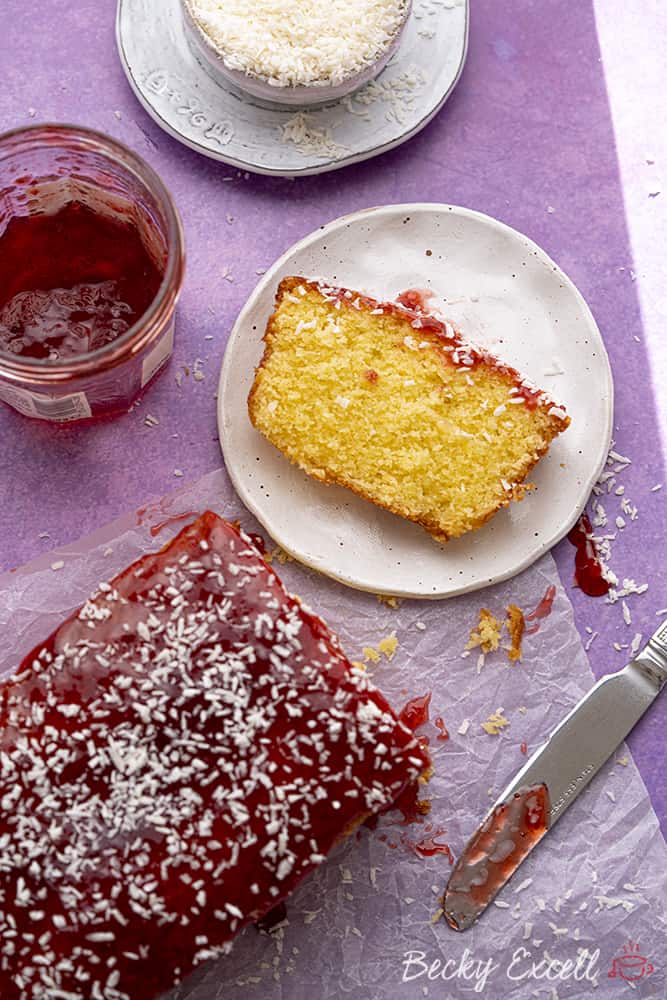 Gluten-free raspberry and coconut cake recipe: Method
Gluten-free raspberry and coconut cake recipe: Method
Oh and here’s a printable version of my gluten-free raspberry and coconut cake recipe. Please remember to give it 5 stars if you tried it and enjoyed it as it helps people know it’s worth trying too! ⭐️ Feel free to leave your written reviews in the comments below this post.
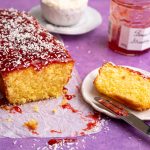
Gluten-free Raspberry and Coconut Cake Recipe (dairy-free option)
Ingredients
For the sponge:
- 175 g butter softened (use Stork hard margarine if dairy-free)
- 175 g caster sugar
- 3 medium or large eggs
- 1 tbsp milk dairy-free if necessary
- 150 g gluten free self raising flour
- 1 ⁄4 tsp xanthan gum
- 50 g desiccated coconut
For the topping
- 200 g raspberry or strawberry jam
- desiccated coconut to sprinkle on top
Instructions
- Preheat your oven to 160C Fan / 180C and prepare a 2lb loaf tin with non-stick baking paper.
- In a large mixing bowl, cream together your caster sugar and your softened butter. Cream until lighter and fluffy. I use an electric hand whisk.
- Gradually add your eggs (one at a time) and whisk until combined, also add your milk at this point too.
- Fold in your flour and xanthan gum, followed by folding in your desiccated coconut.
- Spoon your mixture into your loaf tin and ensure its nice and evenly flat.
- Bake for around 45-50 minutes until golden (remember never to open the oven until you think it's definitely done). To check it's cooked, insert a skewer and if it comes out clean, it's done!
- Leave to cool in the tin for a good 30 minutes before lifting out onto a cooling rack.
- Once cooled spread your jam over the top of the sponge. (I always spoon my jam into a bowl first and mix it to smooth it out a bit as well as briefly putting in the microwave (30 seconds) - not to make it hot but to make it more spreadable)
- Then sprinkle your desiccated coconut on top of the jam. As much or as little as you like.
- Slice and enjoy! It works amazingly with custard.
Nutrition
Any questions about the recipe? Please do let me know by following me on Instagram and leaving me a comment on a recent photo!
If you want to send me a photo of how your bake turned out, you can request to join my Facebook group and post it there. Myself and everyone else would love to see it!
Thanks for reading,
Becky xxx
Don’t forget to pin this for later!

